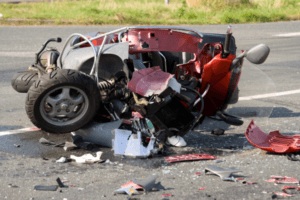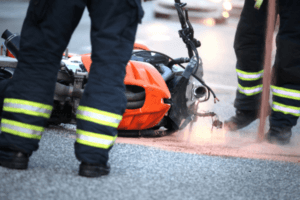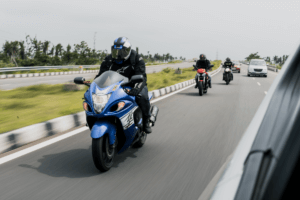Severe accidents are an unfortunate reality for many motorcyclists on U.S. roads. Even the most seasoned motorcycle rider is at high risk of injury if they are involved in a crash with a larger vehicle. With limited protection, riders are in a particularly vulnerable state if they lose control or another driver is careless. What is the primary cause of motorcycle crashes?
Why are motorcycle deaths increasing in our state despite the decrease in vehicles on the road? What can be done to help this growing problem and to keep Texas riders safe? Read below for the common factors that contribute to bike crashes and safety tips from an experienced motorcycle accident lawyer so that we can try to prevent these devastating events from happening in the first place.
Common Factors That Cause Motorcycle Accidents
According to the Texas Department of Transportation (TxDOT), there were over 9,000 motorcycle accidents resulting in injury or death in 2022 alone. Of the 562 fatalities, 39% of them were in crashes where the individual was not wearing a helmet.
While failing to use appropriate safety gear is a main risk when riding a bike, there are additional factors that are commonly associated with motorcycle accidents, including:
- Inattention or negligence: When other motorists do not take care to check for vehicles in all directions, they can overlook a motorbike due to its size. If a driver fails to pay attention to their surroundings while driving, a motorcyclist can easily be missed and possibly hit.
- Failing to notice motorcycles: This is especially common at intersections, where most drivers can be quick to make turns without checking that it’s safe and clear to do so. Whether they are rushing to beat a traffic light or are simply in a hurry to get somewhere, it is all too common for drivers to fail to notice oncoming motorcyclists at an intersection.
- Driving under the influence: Driving while impaired, whether from drugs or alcohol, on Texas roads heavily increases the likelihood of any accident. Motorcyclists are particularly vulnerable to intoxicated drivers because they can be difficult to see and are not as protected as those driving or riding in passenger vehicles on the road.
- Motorists driving while distracted: Drivers are more likely to completely miss seeing a nearby motorcyclist if they are texting, talking on the phone, or engaging in any other distracted driving behaviors.
- Motorists driving too close to motorcycles: Motorcyclists have a much shorter stopping distance compared to traditional vehicles, increasing the likelihood of being rear-ended by drivers tailgating or trailing too close behind them. They may also cause sideswipe accidents if they fail to check their side view mirrors before changing lanes or while lane splitting.
- Motorcycle defects: Even the slightest malfunction or defect within a motorcycle part can cause an accident and lead to catastrophic injuries for motorcyclists and surrounding drivers.
- Hazards on the road: Debris, potholes, and road obstructions pose major threats to motorcyclists. Poor weather conditions can also leave the road surface slick and limit visibility through a motorcycle helmet.
Unfortunately, the common trend among these causes of motorcycle accidents is the negligent actions of nearby motorists. This means motorcyclists must be extra vigilant every time they travel from one place to another on their bikes.
Safety Tips To Prevent Motorcycle Accidents
In an effort to curb the increasing numbers of motorcyclist fatalities, organizations like TxDOT have ramped up safety campaigns such as “Share the Road: Look Twice for Motorcycles” and “#EndTheStreakTX.” These programs are geared toward raising awareness and encouraging drivers to make safe choices and be aware of their surroundings on Texas roads. Yet, is it enough?
While the prevalence of motorcycle accidents in Texas is a scary reality, there are ways in which drivers and motorcyclists can work together to prevent crashes and injuries. Follow the suggested safety tips below to help keep drivers, motorcycle riders, and passengers safe.
- Always look twice when changing lanes: Drivers should always double-check their mirrors and blind spots and use their turn signals before changing lanes. It’s easy for a small bike to be hidden from view until it’s too late to avoid an accident.
- Slow down and obey speed limits: Speed limits are put into place to keep everyone safe. Both motorcyclists and drivers should travel at the suggested speed at all times.
- Give motorcyclists space: Drivers should avoid tailgating or driving too close to motorcycles in case there is a sudden stop or need to slow down. If passing a bike, a truck driver or other passenger vehicle driver should leave plenty of space between their vehicle and a motorcyclist to ensure everyone’s safety.
- Pay extra attention while at intersections: Too many motorcycle accidents happen at intersections due to drivers completely failing to notice nearby motorcyclists. Always keep an eye out.
- Provide space during a left turn: Left turns can be dangerous for those riding a motorcycle. When possible, let the motorcyclist pass first and avoid turning in front of them at stop signs and intersections.
- Drive with vigilance and full attention: Even the slightest distraction can cause the most devastating roadway accident. All motorists should keep their eyes on the road and should be aware of their surroundings at all times.
Dealing With Insurance Companies After an Accident
All drivers in Texas are required to carry liability automotive insurance to pay for damages and injuries when they are found at fault for an accident. Because motorcycle riders are often seriously hurt after a crash and have substantial medical bills, they may exhaust the limits of the liable driver’s coverage. Even in a minor wreck, dealing with an insurance adjuster can be frustrating as they try to prevent fraud when the rider just needs their bills paid.
Unfortunately, bikers face a very real phenomenon called “motorcycle bias.” This bias means both the insurance company and other drivers expect that motorcyclists are prone to driving fast and taking chances with the law. This bias can make it more challenging to prove the other motorist is at fault or that you don’t bear any blame for the crash.
If a settlement agreement can’t be reached, the injured rider may need to file a personal injury lawsuit. However, a jury may also be subject to motorcycle bias. In these instances, it can help to engage a motorcycle accident attorney who is skilled in negotiating against these prejudices to secure the compensation the injured victim deserves.
Motorcycle Accidents Can Be Severe and Costly

In Texas, drivers are only required to carry a minimum of $60,000 of insurance for injuries per accident and $25,000 for property damage. When you add up potential emergency transport, ER costs, ICU stays, and surgery, most motorcycle riders will need far more than that just to regain consciousness. Once they are past the worst of it, they often need rehabilitation and physical therapy services to walk and function again.
Other costs include repairing or replacing property, such as the motorcycle, cell phone, expensive riding gear, and computer. On top of this, the excruciating pain, mental trauma, and isolation riders may feel if they are disabled or scarred must be accounted for in the list of damages. Unfortunately, many insurance policies only cover injuries and property damage, meaning your emotional suffering is unaddressed.
Common Injuries After a Motorcycle Accident

Motorcyclists have no such protection. They can only depend on their riding skill, safety gear, and the attention of other drivers. When they are in an accident, bike riders may be injured by any of three kinds of trauma:
Blunt Force Trauma
When an object strikes the rider, or they are thrown into an object, they experience blunt force trauma. In the worst instances, this is enough to kill a rider on impact. This force can damage your bones, head, internal organs, muscles, neck, and spine. Even those who are wearing an approved helmet can suffer traumatic brain injuries (TBIs).
Decelerating Trauma
A sudden stop during a rear-end or head-on collision puts tremendous strain on the body due to deceleration. One of the most common injuries happens when the rider’s brain is moved suddenly inside the skull, resulting in a coup-contrecoup injury. Internal organs can also be compressed or crushed by stopping unexpectedly.
Penetrating Trauma
When a foreign object enters the body, lungs, bowels, and other areas, organs can be punctured. Many riders wear full motorcycle leathers yet can still suffer penetrating trauma if their ribs are broken.
Common Injuries in Motorcycle Crashes
Regardless of the details of their accident, motorcycle riders are prone to a variety of severe injuries, including:
- Amputation
- Burns
- Cuts, lacerations, and bruises
- Fluid in the lungs
- Head and brain injuries
- Infection
- Internal bleeding
- Lung collapse
- Organ failure
- Reproductive organ damage
- Road rash
When You Need to Go to Court for a Motorcycle Accident
In many instances, you may be unable to secure the full amount needed to support your physical and mental recovery from a motorcycle accident. When this happens, you may need to end negotiations with the insurance company and take the defendant to court. This action involves filing a personal injury lawsuit and having your case heard in front of a judge and jury. Usually, the same lawyer who was handling your insurance negotiations will have prepared your case for the chance you’d need to go to trial.
During both insurance discussions and your trial, a seasoned motorcycle accident lawyer will investigate all aspects of your crash, collect the relevant evidence, and prepare a compelling presentation of the facts. They will demonstrate negligence on the part of the defendant, showing the other party’s liability for your injuries. Your personal injury attorney will work to persuade the court that you deserve financial relief for the serious harm you have experienced.
It’s important that you rely on a lawyer who has a strong background in motorcycle cases because they are not the same as standard car or truck accidents. These claims require a solid understanding of motorcycle bias and the specifics of injuries that riders suffer. Most of all, you need a legal advocate you can trust to manage your claim while you concentrate on getting better.
Houston Motorcycle Accident Lawyers
With their severe nature, motorcycle accidents can be traumatizing for all parties involved. Injuries sustained in these types of motor vehicle accidents can last a lifetime. The physical and financial recovery from motorcycle accidents can be a huge burden on victims and their loved ones.
We know how distressing an accident like this can be, and we want to help. If you or someone you know has been injured in a motorcycle crash, it is important to get help so the negligent party can be held responsible. Get the help and financial compensation you deserve after a motorcycle accident by contacting J.D. Silva & Associates today to discuss your options.

